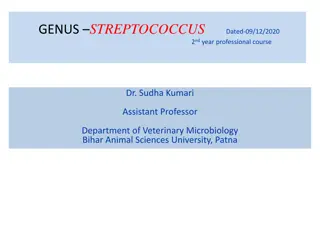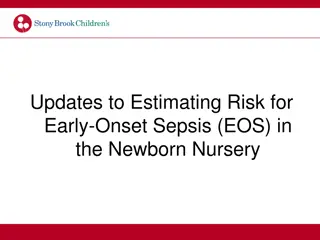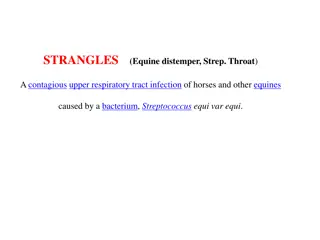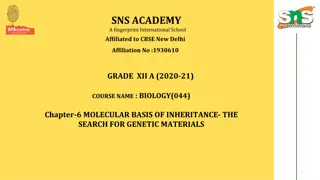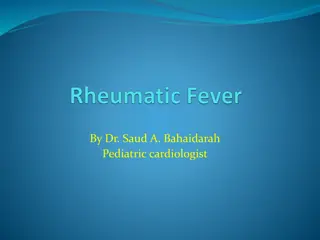Overview of Streptococcus Bacteria and Classification
Streptococcus is a genus of gram-positive bacteria commonly found on skin and mucous membranes. It includes pathogenic and non-pathogenic species, with cell division along a single axis forming pairs or chains. The bacteria were first observed by Billroth and named by Ogston. Different types of stre
0 views • 28 slides
Understanding Early-Onset Sepsis (EOS) Risk Factors and Management in Newborns
Neonatal Early-Onset Sepsis (EOS) is a rare but life-threatening condition primarily caused by Group B Streptococcus (GBS) or Escherichia coli. Recognizing risk factors such as maternal age, intrapartum fever, GBS colonization, and certain neonatal characteristics is crucial for timely evaluation an
0 views • 26 slides
Understanding Strangles in Horses: Causes, Symptoms, and Treatment
Strangles is a contagious upper respiratory tract infection in horses caused by Streptococcus equi var equi. It is characterized by inflammation, swelling, and lymph node abscesses. Transmission occurs through direct or indirect contact, leading to symptoms like depression, fever, nasal discharge, a
0 views • 11 slides
Exploring the Molecular Basis of Inheritance: From Griffith's Transformation Principle to Avery's DNA Identification
Discover the fascinating journey of uncovering genetic materials, from Frederick Griffith's transformation principle with Streptococcus pneumoniae to Oswald Avery's identification of DNA as the transforming substance. Follow the biochemical characteristics studied by Avery, MacLeod, and McCarty, lea
1 views • 9 slides
Overview of Streptococci and Their Classification in Medical Microbiology
Streptococci are diverse Gram-positive bacteria found in nature, some of which are part of the human microbiota while others cause diseases. This article discusses the morphology, classification, hemolysis properties, Lancefield grouping, and details about Streptococcus pyogenes, a significant human
0 views • 21 slides
Understanding Streptococci: Classification and Characteristics
Streptococci are Gram-positive cocci commonly found in chains or pairs. This article covers their classification based on hemolysis patterns and Lancefield grouping, along with general characteristics and principles of differentiation tests. Learn about the infections caused by different Streptococc
0 views • 39 slides
Overview of Necrotizing Pneumonia in Children
Necrotizing pneumonia in children is characterized by necrosis of pulmonary tissue, leading to the formation of small cavities containing necrotic debris or fluid. Staphylococcus Aureus and Streptococcus Pneumoniae are common pathogens. Treatment involves a prolonged course of IV antibiotics tailore
0 views • 34 slides
Rheumatic Fever: A Comprehensive Overview of Epidemiology, Pathogenesis, and Clinical Features
Rheumatic fever is a delayed autoimmune reaction to group A, B-hemolytic streptococcal pharyngitis in genetically susceptible individuals. This condition involves the heart, joints, brain, skin, and serous surfaces. The incidence varies between developing and developed countries, with environmental
0 views • 31 slides
Overview of Pharyngitis: Symptoms, Causes, and Classification
Pharyngitis is characterized by sore throat, categorized as acute or chronic. Acute pharyngitis has a sudden onset, while chronic pharyngitis persists longer. Chronic types include hypertrophic, atrophic, and granular, each with specific characteristics. Majority of cases are viral, with streptococc
1 views • 16 slides
